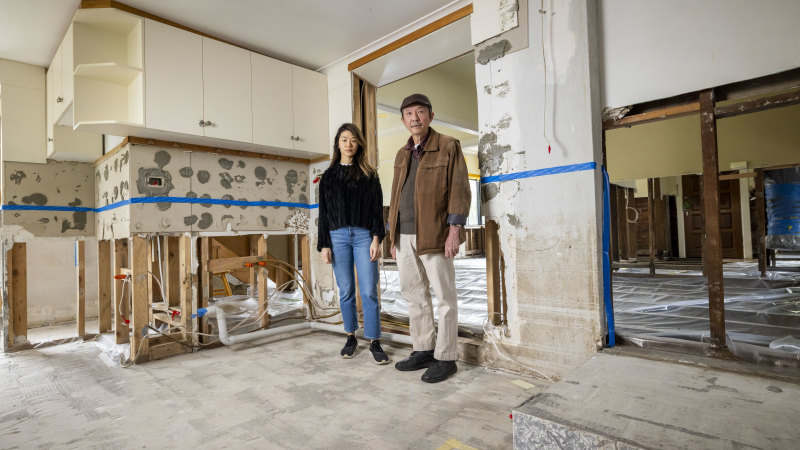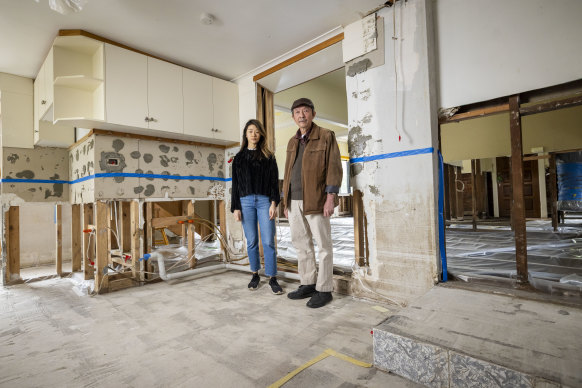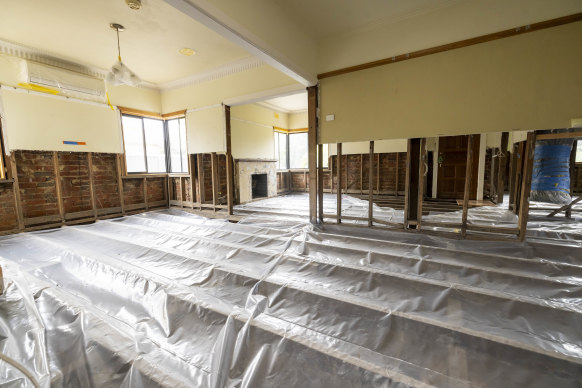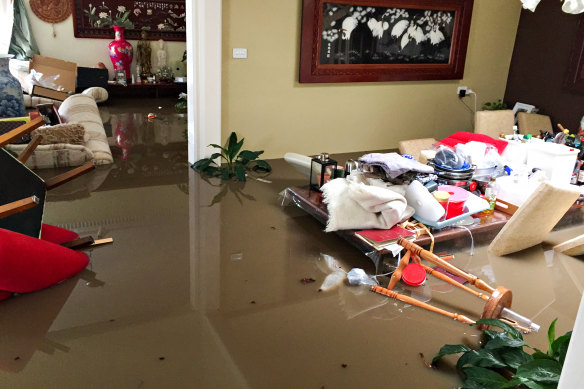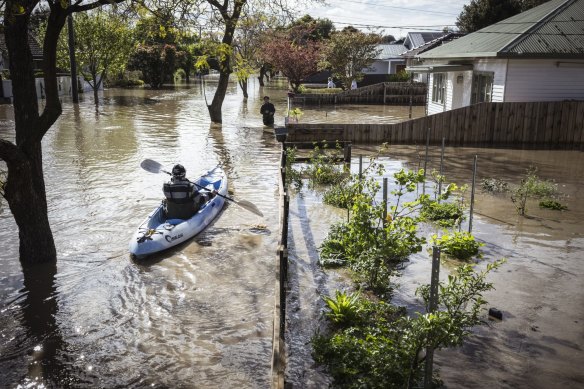Save articles for later
Add articles to your saved list and come back to them any time.
A report into last year’s Maribyrnong River floods says a long-proposed dam on the river in Keilor – that would slow floodwaters when a big deluge hit – should be abandoned because of its cost and environmental toll.
The Arundel retarding basin, repeatedly put forward since the 1970s but never built, would allow engineers to dictate how much water flowed into the Maribyrnong River downstream of Keilor during a flood.
Paul Lau with daughter Stephanie in their flood-damaged Maribyrnong home. The blue line shows where floodwaters rose to in the house, which remains unrepaired.Credit: Wayne Taylor
But a report for Melbourne Water, which also recommends investigating buybacks of homes at risk of flooding in the suburb of Maribyrnong and construction of a levee on the river’s banks, says the dam should not be built.
The report comes as a parliamentary inquiry, called into the floods after an investigation by The Age into Melbourne Water’s response, will on Wednesday hear from Water Minister Harriet Shing and Emergency Services Minister Jaclyn Symes. Tony Pagone, the head of Melbourne Water’s separate inquiry, will also appear.
The Melbourne Water report, by consultants Water4Good, found the long-proposed Arundel flood prevention project would cost around $200 million to build. The project would see a wall connected to a spillway built across the Maribyrnong in Keilor. When proposed in 1986, the dam was to cost $16.2 million, equating to $48 million in today’s dollars (although construction costs have vastly outpaced inflation).
While the retarding basin would only be used during big downpours, it should not be built, the report said: “The cost of the option, and the environmental, cultural heritage and upstream impacts render the business case unviable.”
The report also found building the dam would increase flooding of land around Keilor including in the popular Organ Pipes National Park. “Environmental impacts would be significant,” it said, with the dam wall blocking the “passage of fish, platypus, turtles and other aquatic fauna”.
Several Maribyrnong residents and water experts, though, argue the dam is the best option to stop hundreds of millions of dollars of flood damage in built-up city areas.
Retired water expert Ron Sutherland was part of the government authority that in 1986 recommended Arundel be built. He said its design meant it would not affect the Organ Pipes or cause environmental damage. “Melbourne Water’s report incorrectly claims Arundel would be detrimental to the Organ Pipes.”
Among Maribyrnong residents who also want the project built is 67-year-old mental health worker Paul Lau. More than a year since the floods, he and wife Jackie Wong have not been able to return home, with their insurer Allianz barely starting repair works.
Lau and Wong’s Maribyrnong home has sat empty for more than a year, waiting for repair works to begin.Credit: Wayne Taylor
Lau and Wong came to Australia as refugees in the 1980s and bought their house in 1990. Lau has seen previous deluges in the suburb but last year’s was the first time floodwater entered his home. The couple had no warning their house would be inundated last October until emergency workers knocked on the door at 4.30am.
“I had enough time to move my car and my wife’s car to higher ground and when I ran back, the water had started coming through the house and rising from the floorboards. I could hear the gurgling noise coming from the toilets. We did not have time to move anything.”
Floodwaters peaked inside the house at more than one metre. “I was wading in the water trying to do as much as I can, and I’m shivering with this stinking water, sewage and mud, and petrol from the petrol station nearby, all around me.”
Lau said the speed of flooding inside his home shocked him. “I thought we’d see the water rising slowly and predictably but the water rushing in was frightening.” Despite Lau and Wong’s house remaining unrepaired for months on end, their insurance premiums have skyrocketed. “It’s going to be around $7000 a year now.”
Paul Lau and Jackie Wong’s Maribyrnong home during the October 2022 floods.Credit: Lau family
Lau is among scores of Maribyrnong residents who want Arundel built to floodproof their suburb. “We suffer from extreme anxiety every time we see a forecast for heavy rain.”
Maribyrnong resident Lee Lanzafame, who also wants Arundel built, said Melbourne Water had vastly overstated its construction cost, and downplayed the number of homes flooded last year. “They seem intent on inflating the cost of the retarding basin and minimising the cost of the damages to the homes.”
The report also says a levee around Maribyrnong should also be explored, which would involve “building a significantly high embankment, up to three to four metres in places, which is likely to raise issues with visual and recreational amenity of the area”.
It would require around 10 homes in Maribyrnong to be acquired by Melbourne Water. “It is likely this would be a contentious issue among the community.”
The flooded streets of Maribyrnong last October, after the river burst its banks.Credit: Chris Hopkins
The report also found that compulsory acquisition of 212 properties in Maribyrnong within the flood zone “would be extremely expensive and not feasible for several reasons. … However, it is a mechanism that has been utilised by other governments in Australia e.g., Queensland’s $741 million voluntary home buy-back.”
A Melbourne Water spokesman said the authority had revisited the options to prevent flooding a number of times since the 1980s, and the most recent report had concluded there were many issues associated with building a dam at Arundel.
“These include the need for compulsory acquisition of properties, impacts to the local community, [the low] cost benefit, significant cultural values, and major environmental impacts to threatened flora and fauna, fish, turtles and platypus, and the Organ Pipes National Park,” he said.
He noted that the report also recommended looking at other options such as smaller retarding basins and deepening or widening the river.
Start the day with a summary of the day’s most important and interesting stories, analysis and insights. Sign up for our Morning Edition newsletter.
Most Viewed in Politics
From our partners
Source: Read Full Article
